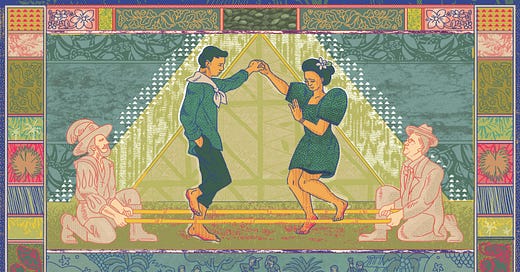Behind the illustrations with Michelle Lagasca
I took some time to chat with illustrator Michelle Lagasca about the inspiration behind the images she created for my story on colonial mentality in today's (Q&A) newsletter.
Hi Michelle, thanks so much for doing the illustrations for my story on the impact of colonial mentality on Filipino American mental health! Before we dive into chatting about the illustrations, I'd love if you could share a little bit about yourself and how you got into illustrating.
Hello! I'm a Filipino American illustrator and graphic designer born and raised in the Bay Area. My parents and grandparents immigrated in the ’80s from the Philippines to San Francisco where I grew up scribbling on walls and old magazines. I used to be a quiet kid and drawing was my main mode of communication. Today, I still prefer to communicate with visuals and am happy to hold conversations in strings of GIFs and doodles. During the day I work at Humane Society Silicon Valley, using my design and illustration skills to promote human and animal welfare. I am also passionate about Asian American issues, which is why it was such a thrill to have worked on this story.
We were all really thrilled to work with you, too. I remember how excited my editors and I were when we saw your three initial sketches and the final two images. We were amazed with how you were able to convey colonial mentality in two visuals. They're so good! You also came up with them in just a few days. What was the creative process like from start to finish? How did you come up with the concepts for both images?
From the beginning, I knew there were two main concepts from your story that I wanted to visualize.
First, I wanted to explore the Filipino cultural touchstone of entertainment and hospitality. Singing, dancing, playing music, and in general, appeasing others. For this concept, I came up with the metaphor of a coerced Tinikling dance. Tinikling is both performance and game. Bamboo poles are clapped together while barefoot dancers hop in and out of the movement. The tempo grows along with the potential for broken ankles. Here, the poles are controlled by colonists, turning this performance into a coercion. You wrote that FilAm employees are often said to be jolly and hard-working, but are rarely promoted. The dancers in the illustration are dancing for entertainment but are being forced to do so by the colonists, rather than being willing participants.
Initially, my sketch portrayed only Spanish colonists, but it was suggested that I change one to an American colonist for the final.
For the second piece, I wanted to explore the colonial effects on Filipino beauty standards. The way we view our bodies has been colonized the same way our physical lands have been colonized. For this, I presented an option of a Filipino woman in her "natural" state, being discovered by a Spanish galleon, with the implication that she'll soon be subject to colonization the same way the Philippine islands were.
I also presented another option where the same two subjects are inside an impossible bottle, unable to escape. The ship belongs inside the bottle but the individual does not.
The team suggested that I mix the two concepts together and I think it was the right choice!
During the sketch process, I intentionally leave the "frames" vague and repetitive, since I'm saving what goes into them until the concepts are finalized and approved by the team. Once they are, I get to work on the lineart first, which is the "skeleton" of the piece.
The last part is my favorite! Adding color, texture, and pattern. The repetitive square framing and various patterns were inspired by Filipino textiles as well as handwoven mats called "banig." I used to sleep on a banig at my grandparents' growing up, so the geometric patterns are burned into my mind.
The details in the borders are fascinating because they’re filled with significant and meaningful images and words. Can you talk about some of the phrases and pictures you placed throughout the illustrations? Why did you include them and why are they important?
I love illustrations that are a little bit educational. Here are a few tidbits:
These are amazing! I actually didn’t know the Philippines had a national leaf, so I learned something new today. Thanks so much for taking the time to share more about the process and details behind the illustrations. My last question for you is, what do you hope people who view these illustrations take away from them?
I think there will be two types of viewers.
First is the viewer with the fresh eyes. I want the fresh-eyed viewer to see the objects in the illustration and wonder what they are and be pushed to do their own research. What are those bamboo sticks? What is Likas? What is Bataan? I want them to have questions, and to hold these questions in their pocket with them long after they've read this piece.
Second is the viewer with the seasoned eyes. The seasoned viewer will see the illustrations and already know what it's about. They know about Tinikling, they know about Likas soap, and they know about Bataan. I want the seasoned viewer to feel seen and to know that much thought is being put into their visibility. I want them to know that there are people out there with questions for them, and that they deserve to have a voice and to not be spoken for.
I hope for these two types of viewers to find each other and have a dialogue.










